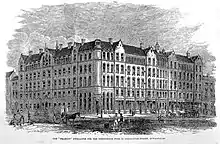Henry Darbishire
Henry Astley Darbishire (15 May 1825 – 1899) was a British architect, best known for working on philanthropic schemes. He worked on projects for Angela Burdett-Coutts, and was the architect for the Peabody Trust from 1863 until 1885,[1] when he was succeeded by Victor Wilkins.[2]
He was of Mancunian origin,[3] the son of James Darbishire and his wife Mary Roberts.[4] He qualified as a Fellow of the Royal Institute of British Architects in 1856, and finally retired from practice in 1894.[3]
Darbishire married Eliza Paget in 1858, and they had three children.[4]

Peabody dwellings, Commercial Street, London, designed by Darbishire: a wood-engraving published in the Illustrated London News in 1863, shortly before the building opened
Notable works
- Columbia Square, Bethnal Green (1857–60), demolished
- Baroness Burdett Coutts Drinking Fountain, Victoria Park, London (1862)
- Peabody dwellings, Commercial Street, Spitalfields (1864)
- Holly Village, Highgate, London (1865)[5]
- Peabody Estate, Islington (1865)
- Columbia Market, Bethnal Green (1866), demolished
- Peabody Estate, Shadwell (1866)
- Guilford Place drinking fountain (1870)
- Peabody Square, Blackfriars Road, Bermondsey (1871)
- Peabody Estate, Pimlico (1876)
- Peabody Estate, Whitechapel (1881)
References
- "housing association | History of estates | London". Peabody. Retrieved 2016-11-05.
- "In praise of the Peabody Estates". Apollo-magazine.com. Retrieved 2016-11-05.
- Davidovici 2017, p. 62.
- "Paget Family". Anatpro.com. Retrieved 2016-11-05.
- "Darbishire, Henry Astley - Dictionary definition of Darbishire, Henry Astley | Encyclopedia.com: FREE online dictionary". Encyclopedia.com. Retrieved 2016-11-05.
Further reading
- Davidovici, Irina (2017). "Renewable principles in Henry Astley Darbishire's Peabody estates, 1864 to 1885". In Guillery, Peter; Kroll, David (eds.). Mobilising Housing Histories: learning from London's past. London: RIBA Publishing. pp. 57–73. ISBN 9781859466315.
- Placzek, Adolf K., ed. (1982). "Henry Astley Darbishire". Macmillan Encyclopedia of Architects. Vol. 1. London: Collier Macmillan. p. 502. ISBN 0029250005.
This article is issued from Wikipedia. The text is licensed under Creative Commons - Attribution - Sharealike. Additional terms may apply for the media files.